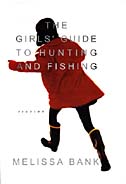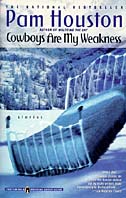|


Comment
on this story
|
|

Female authors investigate women who love bad boys
by Jeanne McDonald
Why are so many women attracted to males with an aura of danger about them, even though they know the relationship will end badly? I have an otherwise intelligent friend whose ideal man has a motorcycle, a thick mustache, hair long enough to make a ponytail, and just enough education to argue that his leading questions are actually rhetorical. He wears tight jeans, a tight T-shirt, a black leather jacket (also tight) and the absolutely requisite accessory—a pair of well-worn but expensive cowboy boots. Real ones.
He's the type who will decimate a woman's heart and checking account in one ruthless sweep. And this is exactly the kind of man Pam Houston's narrator always falls for in her collection of stories, Cowboys Are My Weakness (Pocket, $14), finally back in print after a five-year absence. Worse, she keeps falling for him over and over—different man, same ploys. "I've always had this thing about cowboys," the otherwise intelligent narrator says in the title story, "maybe because I was born in New Jersey. I thought Homer was a cowboy...[but] I had to face the fact that...he was just a capitalist with a Texas accent who owned a horse."
Houston's narrator is savvy enough to be aware that her affairs with these rugged types are pretty unstable, but to maintain them, she braves rapids and rugged terrain and competes not only with other women, but wild animals. In "What Shock Heard," her hunter "laughed and reached towards me and I thought for me, but then his hand came down on the neck of a six-point mule deer mounted on the wall...'Isn't he beautiful?' he asked."
Eventually, as her cowboys, hunters, and river-running outdoorsmen continue to use and occasionally abuse her, she begins to comprehend that she's not going to end up with anything on her finger except a Band-aid, bruise, or blister.
Houston is an exceptionally talented writer who can describe her harrowing adventures so stunningly, the reader is pitched into the paralyzing cold and terror of being lost in the dark on a snowy mountain inhabited by bears or swept along on the roller coaster ride of a wild and rain-swollen river. "At the time I was writing Cowboys," she says in an interview published in this edition of Cowboys, "I was spending over a hundred nights a year outdoors because I was a river guide, and a hunting guide, and because I had taken a personal vow to spend every full moon night outside no matter what... Outside is better. Even in a hurricane. Even when it's thirty below."
Houston won't apologize for writing a "whole book about women who let men become the most important element in their lives" and no apologies are needed, because Cowboys is much deeper than that. It's a book packed with powerful stories, complex characters, and a shrewd understanding of the human condition.
In comparison, The Girls' Guide to Hunting and Fishing, by Melissa Bank (Viking, $23.95), is a disappointment, though it is not without its wry and insightful observations. This collection is a series of related tales that chronicle the life of Jane and the men in her life—first her doctor-father and her older brother Henry, then her less-than-constant college boyfriend Jamie, and later, Archie, the "older man" and book editor, with whom making love becomes "manual labor" for Jane. Here, the stories are set in posh urban restaurants, on the beach at Nantucket, or at elitist publishing parties. While Houston's stories flow like an uninterrupted mountain stream, Banks' book screeches to an abrupt halt in the middle, where she sneaks in an entirely unrelated chapter that has nothing to do with the rest of the book. Okay, so she sticks Jane's name into the dialogue on the first page, but that's it. And for those looking for tales of outdoor adventure, the title cheats. The only prey here turns out to be Jane or her boyfriends, and physical activity is limited to indoor sports. It's not an entire loss, though. Banks' style is crisp and comic, much like the sharply sketched minimalist stories of Amy Hempel, and she has a brisk, straightforward style that captures perfectly the modern manners and morals of big city life.
In Cowboys, the narrator's reward is finding herself, while in Guide, Jane finally nets Prince Charming. She might have found him sooner, had she bitten her tongue instead of saying cutesy things like "I'm a truthball in search of goof."
On a hefty page of acknowledgments, Banks thanks a long list of friends, editors and readers who helped her with the book. If only one of them had convinced her to leave out the unrelated middle chapter, we would have had a much more cohesive story.

February 17, 2000 * Vol. 10, No. 7
© 2000 Metro Pulse
|